I was going to talk about a cool recent paper that described the evolution of novelties by way of modifying modular gene networks, but I started scribbling it up and realized that I was constantly backtracking to explain some fundamental concepts, so I stopped. I was concerned because one of the most common sources of confusion I’ve found in my students in the past was difficulty in distinguishing phenotypes from the complexities of the underlying genotype, and I have to be slow and thorough in setting up those differences early on until it sinks in, a habit I’m continuing here. It’s so easy for students to reify a trait, like eye color, into a single discrete property that must be somewhere on a chromosome. It’s not. It’s so much messier than that.
Let’s talk about eye color in flies. Drosophila eyes have a characteristic brick red color, and the most famous mutation in flies is white, which produces distinctly white-eyed flies. Eye color is too complex to be described as the product of a single locus and only two alleles, though: there’s actually a whole battery of genes that work together to produce eye color.
For example, the specific color of the eye is the product of mixing two pigments, drosopterin and xanthommatin, in appropriate proportions in the pigment cells of the eye. So we’ve actually got at least two genes, brown or bw for short, that is part of the pathway that makes drosopterin, a bright red pigment from guanine, and scarlet or st, that’s part of the pathway to make xanthommatin, the brown pigment. Each of these pigments is produced in a more complex way than is illustrated here — xanthommatin is produced from the amino acid tryptophan by a series of enzymes, tryptophan pyrrolase, formamidase, kynurenine-3-hydroxylase, and phenoxazinone synthetase — but this story is already complicated enough, so in this diagram we reduce all that to just a couple of arrows.
So there are two parallel pathways to produce the eye color. There is a brown pathway that produces a red pigment, and a scarlet pathway that produces a brown pigment. The names might be a bit confusing (they always are for my students), but it’s part of a standard genetics convention: the genes are named for their effect in mutants, not wild type forms. If you knock out the brown gene with a mutation, the fly will be unable to make the red pigment, but it will still make the brown pigment, so the eye will look brown. See? Makes perfect sense.
Conversely, if you knock out the scarlet gene with a mutation, the fly will not be able to make the brown pigment, but it will continue to produce the red pigment, so the eye will look bright red.
All you have to do is think about genetics for a few years, and don’t worry, this inversion of names will someday begin to seem perfectly natural. It’s just another peculiarity of the genetical mind that makes geneticists weirdos on campus.
Now for the test: if you knock out both the brown and the scarlet genes, what do you get? They don’t make the brown pigment, and they also don’t make the red pigment, so the eye color would be…?
If you realized it would be unpigmented or white, give yourself a kewpie doll. Eye color is primarily the product of two gene products, a red and brown pigment, which are produced by multi-step enzymatic reactions that offer multiple points for possible disruption. This one trait is the outcome of a whole series of genes.
I mentioned at the beginning that the white-eyed fly was the most famous Drosophila mutant. Have we just explained how that mutant was created? No we have not. As it turns out, the white mutation was in a single gene, but again, not a gene that directly makes a pigment. White is a mutation that makes a defective a transporter protein — the mutant blocks the transport of the precursors tryptophan and guanine into the cell, so it has no raw materials to make the pigments. In the wild-type fly, there is a complex sequence of events that results in the ultimate production of two pigments in the eye.
Defects in white, scarlet, and brown disrupt different events in the sequence, with white upstream, or epistatic, to the other two. White affects both branches of the pathway, while scarlet and brown each affect one.
Whoa, so this is already getting complicated, and we haven’t even dug into the details of each pathway. The proportions of the two pigments that end up in each eye are dependent on the relative rates of each of the two branches, so subtle mutations can change the hue of the eye; variations in intermediate steps can produce aberrant byproducts with odd colors; and of course, this whole collection of genes has to be regulated to be expressed in the right place. The whole fly isn’t brick red, just the eyes, so this process has to be switched on in only a subset of cells.
At this point, you could just give up, if you were a creationist. It’s too complex, there are too many bits and pieces, and everything is interlinked — even if you could get it too evolve, the interdependencies must lock the whole grand network into one rigid pattern where you can’t break one thing without the whole thing collapsing like a house of cards. But you’d be completely wrong.
It’s counter-intuitive, but it turns out that this complexity actually enables the evolution of interesting novelties. I’ll get to that either tomorrow or the day after…be patient.
Diagrams are from Klug, Cummings, Spencer, and Palladino, Concepts of Genetics, 9th edition.
(Also on Sb)

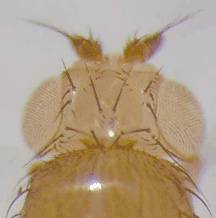
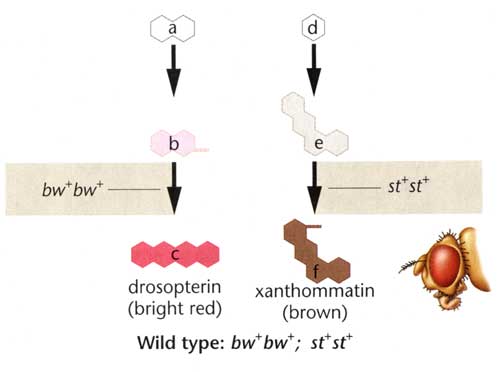
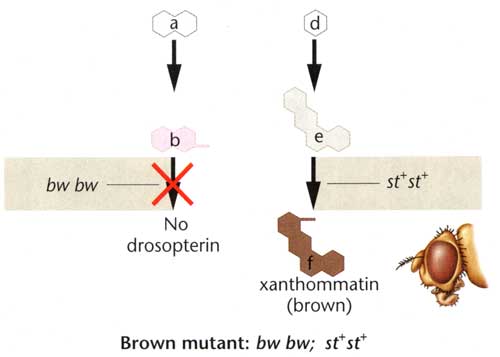
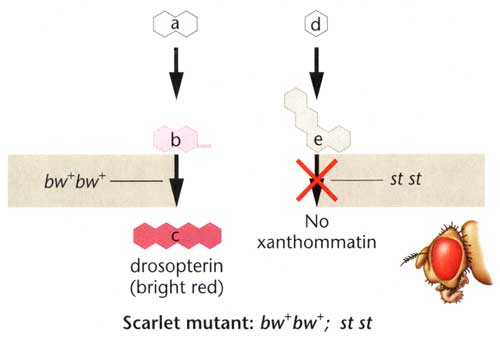


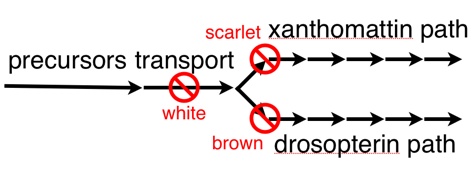

Yumm…Hard science well explained.
Waiting for the rest of this interesting post. Meanwhile, a little typo:
Original: White affects both branches of the pathway, while scarlet and white each affect one.
Should be: White affects both branches of the pathway, while scarlet and brown each affect one.
I totally loved this stuff when I was a student. Thanks for bringing back memories :)
“I used to be a developmental biologist like you until I took an arrow to the diagram.”
“White affects both branches of the pathway, while scarlet and white each affect one.”
I think that second whitey should be a brownie.
Love the class Professor but it is too confusing.
God did it.
Wow, Learning is so easy now.
(Thanks for letting us think, great stuff)
Gah you’re brining back my genetics lab nightmares, trying to memorize the pathways in fly eye pigmentation….. the horror… THE HOORRRRORRR! O.O
Me too. I recall being given Punnett squares for the coat coloring of some generation of dogs (or something like that) and having to work out the dominance and a likely pathway and possible genes involved (three for the pigments, one suppressor gene, etc.)
Most fun exam I’ve ever written.
Folks tend to think of human eye color (iris) as a single gene issue as well and that’s not right. We have eu- and pheo-melanin (black/brown and red/brown) pigments. The iris muscle color is blue. Making matters more interesting, you can have either a lot or a little amount of either pigment. Green eyes, counter intuitively enough, are a mix of the blue base color + a low level of red pigment.
Interestingly, the blue colour is not a function of pigment (in which certain wavelengths are reflected while others absorbed) but of its translucent structure, causing a type of interference called Tyndall scattering which typically looks blue as higher frequency wavelengths are scattered more greatly.
Drosophila can be so fun. Until you use diachete as a phenotype. Those little fuckers can hold their wings together and trick you. And when each fly costs $4.00 US, you really don’t want to mess up.
“All you have to do is think about genetics for a few years, and don’t worry, this inversion of names will someday begin to seem perfectly natural. It’s just another peculiarity of the genetical mind that makes geneticists weirdos on campus.”
So do geneticists invert their light switches so when you flip them up the light goes out? And what do you call the handle on your toilet, the Poo Retainer Lever?
Serious mode: PZ, thanks for sciency posts like this. I luv ’em.
I only get half a kewpie doll, as I figured the eye would be unpigmented, but not necessarily white.
Excellent write-up! Thanks for this. I’m looking forward to sharing it with my own students, and I have now doubt they’ll be able to understand it.
Looking forward to the next part. :)
Hmm… Science. *drool*
Now if only Drosophila biologists could get rid of the bassackwards gene nomenclature. The white gene doesn’t cause white eyes, it causes red eyes. Only if the white gene is non-functional does it cause white eyes. Sigh.
I disagree. For one thing, white doesn’t cause red eyes — it’s a transporter gene. I think it’s better to have arbitrary names which do not trick you into assuming that you know the gene function already.
Mothers against decapentaplegic.... !!This blog used to be so good when it was about feminism. It’s been sad to watch it degrade into the laughingstock of the skeptical world with this politically correct “science” nonsense.
(JOKING)
***
In high school I took a special advanced biology course in high school and one of the things we were going to do was actually breed Drosophila and do some of the classic genetics experiments that normal people are content to read about in books. This was supposedly so we could get some experience working with flies, which we would no doubt do over at some point in the course of our long and successful careers. The experiment was scheduled to start as soon as winter break ended. On the first day of class after break, we learned from the teacher that the flies had not arrived and were on “back order” from the company. A couple weeks later, they were still on “back order”. A month later, they were still on “back order”.
Then, just as we were about to give up, the flies arrived. Yay!
Unfortunately, there was one problem. About 50% of them were dead on arrival, and the rest died within one week (which did give us time to learn how to sex them, at least). So we never got to do the breeding.
I suppose this was good preparation for a career in science.
And of course this fascinating complex process is just the sort of thing a Creator would do—if he were a vile, devious, vicious, right bastard of a Creator he would.
And having looked at Genesis from time to time, I’m starting to think those creationists might just have a point…
:-D
btw
Great, wonderful post!
So I probably lack eumelanin all over my body. =8-)
Except in the few individual hairs with a back-mutation. I have one black (and one white) hair on each wrist, for example.
What’s going on is that genes are named after which mutants they produce when they’re broken. When the brown gene is broken, you get the brown mutant which has brown eyes (xanthommatin only).
(…Doesn’t xanthos mean “yellow”? Or is that just another case of color names simply not lining up between languages? …Omma means “eye”.)
(…Handle? On a toilet? American. Elsewhere it’s a large button, or – in really old ones – a handle on a long chain that hangs from on high.)
@ moarscienceplz
“So do geneticists invert their light switches so when you flip them up the light goes out?”
Such a North American view. Much of the rest of the world does “down = on”. It initially confused the hell out of me when I lived in Barbados. Apparently, Japan does them sideways.
Geneticists don’t have light switches in their homes. They have Dark switches, and when they drive a chisel through the switch with a large hammer, the light stops being expressed and the dark becomes visible.
I have a formal lab next week about this. Thanks, this cleared up the basics quite a bit!
Ha! This was easy. (Because you didn’t use too many sciency words.)
Maybe not, but compared to the baby blue and pale pink/grey, white was a nice, clean backdrop. I can’t speak for the flies that might read this site, of course.
This might be hairsplitting, but Brown and Scarlet are transporters as well, like White. In fact, the nature of the proteins explains the epistasis very nicely. White, Brown, and Scarlet are “half” transporters that must partner with one another in order to function. It is proposed that White dimerizes with Brown to transport the drosopterin precursor; White dimerizes with Scarlet to transport the xanthomattin precursor.
Lose White, lose both transport activities. Lose just Brown or just Scarlet, and one loses xanthomattin or drosopterin, respectively.